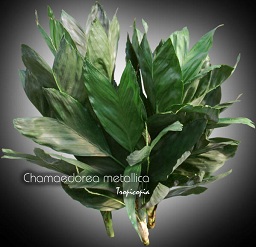Table of contents
Miniature fishtail

Latin Name: Chamaedorea metallica
Category: Palm
Family: Arecaceae
Origin: Mexico
Climate: Tropical
Growing Zones: 11-10
Care Instructions
The Miniature fishtail (Chamaedorea metallica) is a tropical plant that originates from Mexico. This palm plant belongs to the Arecaceae family and is well-suited for growing in USDA zones 11-10.
Complete Care Guide for Miniature Fishtail (Chamaedorea metallica)
Watering Requirements
The Miniature Fishtail, or Chamaedorea metallica, thrives in consistently moist soil but is sensitive to overwatering. It is essential to allow the top inch of soil to dry out between waterings. During the growing season, typically spring and summer, water the plant more frequently, ensuring that the pot has good drainage to prevent root rot. In the fall and winter months, reduce watering as the plant enters a dormant phase. Always check the moisture level by inserting your finger into the soil; if it feels dry, it’s time to water. Using distilled or rainwater is preferable, as this plant can be sensitive to the chemicals found in tap water.
Light Conditions
The Miniature Fishtail prefers bright, indirect light but can tolerate lower light conditions. Direct sunlight can scorch its delicate leaves, so it’s best to place it near a window with filtered light or in a well-lit room. If you notice the leaves turning yellow or dropping, it may be a sign that the plant is receiving too much direct sunlight. Conversely, if the plant becomes leggy or the growth slows, it may not be receiving enough light. A balance is key; aim for a spot where the plant can receive bright, indirect light for most of the day.
Soil Preferences
Chamaedorea metallica thrives in a well-draining potting mix that retains some moisture without becoming soggy. A blend of peat moss, perlite, and orchid bark works well to provide the right balance of aeration and moisture retention. It’s crucial to ensure that the pot has drainage holes to prevent water from accumulating at the bottom. Fertilization should be done during the growing season with a balanced, water-soluble fertilizer diluted to half strength every four to six weeks. In the fall and winter, reduce or eliminate fertilization as the plant’s growth slows.
Pests and Diseases
The Miniature Fishtail can be susceptible to common houseplant pests such as spider mites, mealybugs, and scale. Regularly inspect the undersides of leaves and the stems for any signs of infestation. If you notice pests, treat them promptly with insecticidal soap or neem oil, ensuring to follow the product instructions carefully. Additionally, keep the humidity levels high around the plant, as dry conditions can lead to pest problems. Fungal diseases can also occur, particularly if the plant is overwatered. Ensure good air circulation and avoid wetting the leaves when watering to minimize the risk of fungal infections.
Special Care Tips
To maintain the health and beauty of your Miniature Fishtail, consider the following special care tips: First, regularly dust the leaves with a damp cloth to keep them clean and allow for optimal photosynthesis. This also helps prevent pests from settling on the leaves. Second, maintain a humid environment, as this plant thrives in higher humidity levels; consider using a pebble tray with water or a humidifier, especially in dry indoor conditions. Lastly, be patient with growth; this plant is relatively slow-growing, so don’t be discouraged if you don’t see rapid changes. With proper care, your Miniature Fishtail will reward you with its stunning foliage for years to come.








